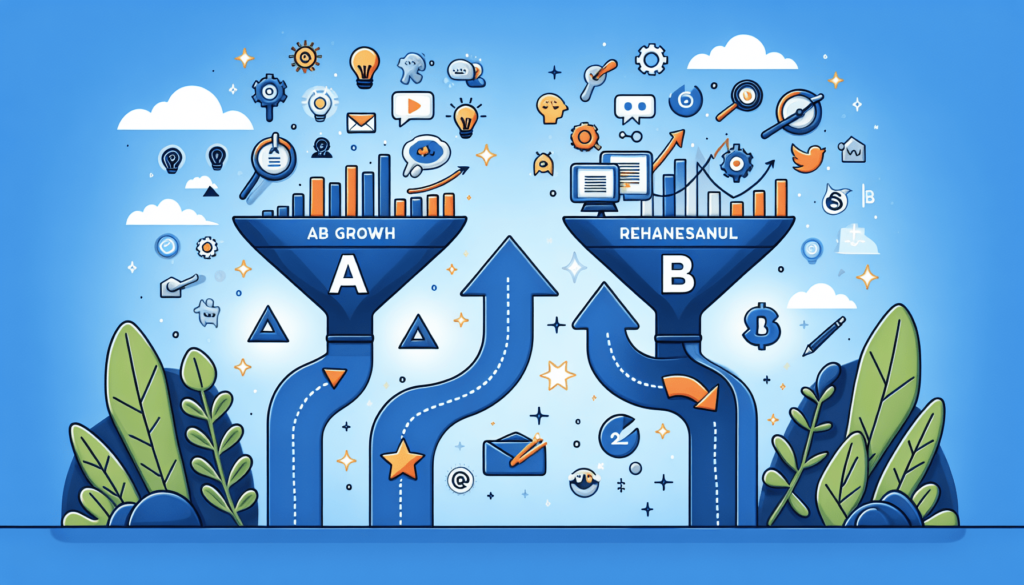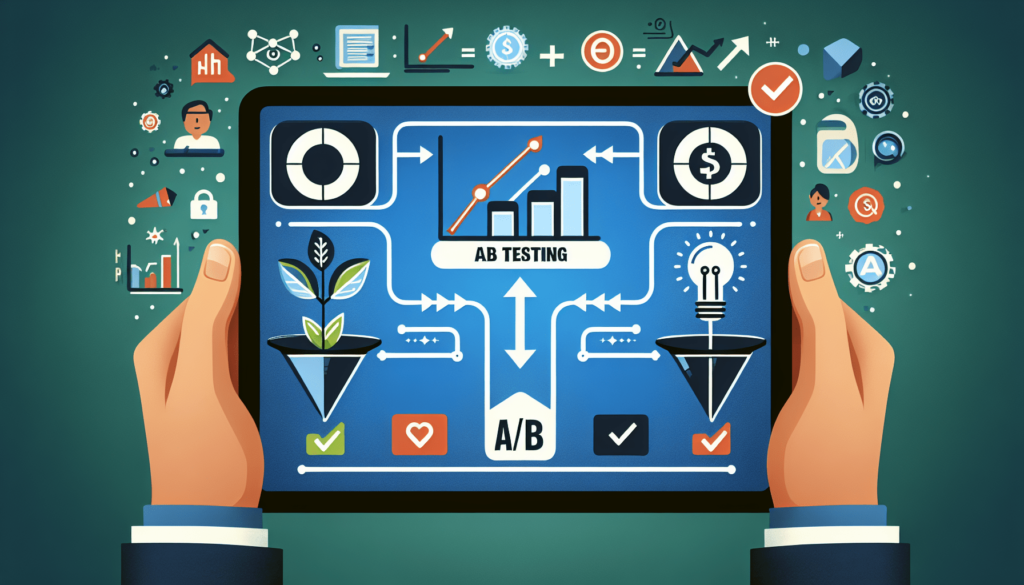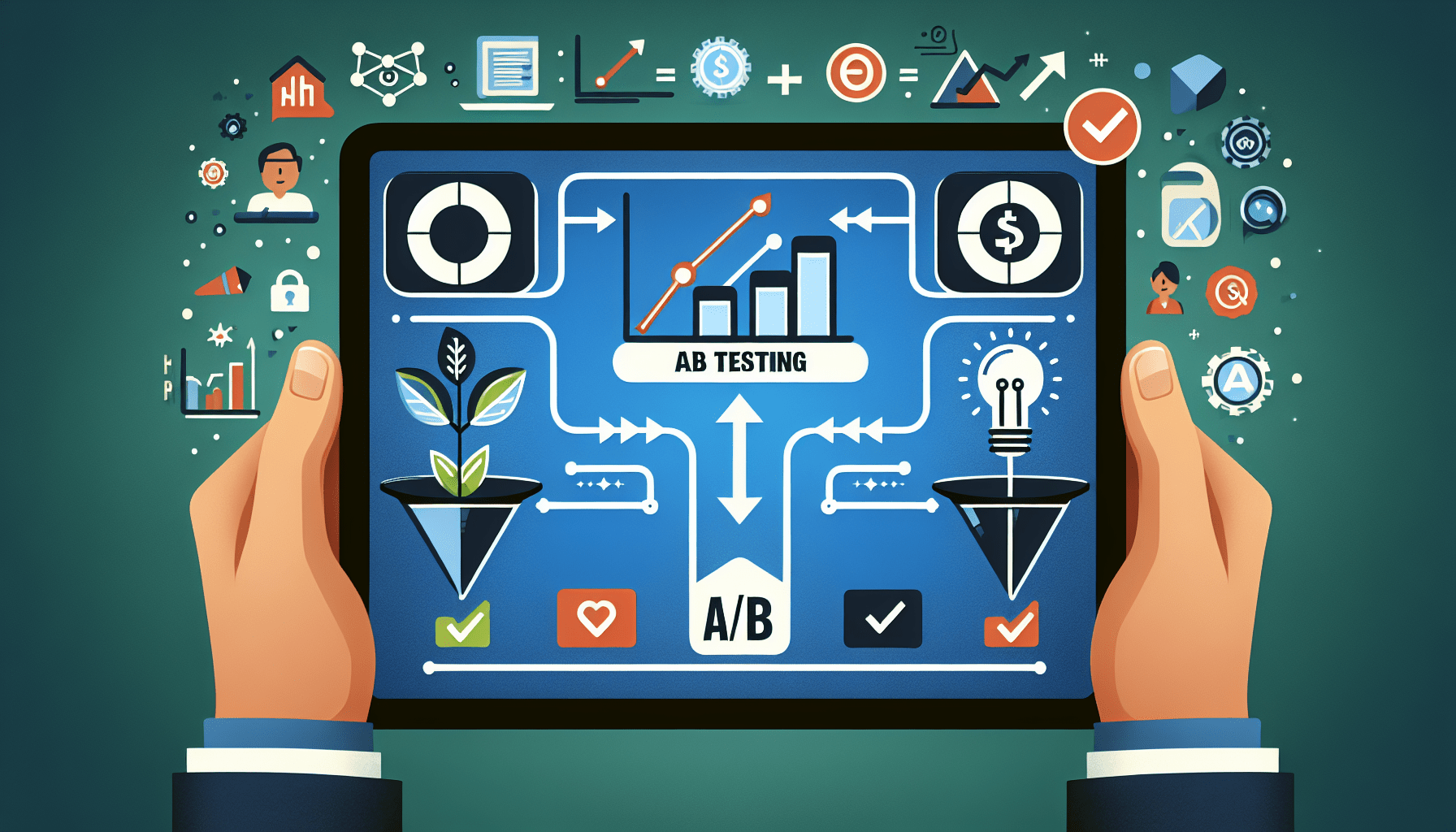You understand the importance of optimizing your sales funnel to drive more conversions and increase revenue. But how can you be sure that the changes you make to your funnel will actually have a positive impact? This is where A/B testing comes in. By testing different variations of your funnel and measuring the outcomes, you can gather valuable data to inform your optimization strategies. A/B testing allows you to make data-driven decisions about the elements that truly impact your conversions and ultimately improve your overall funnel performance.

What is A/B Testing?
Definition of A/B Testing
A/B Testing is a method of comparing two versions of a webpage, email, or other marketing material to determine which one performs better with the goal of increasing conversions. It involves dividing the audience into two groups and showing each group a different version of the element being tested. By measuring the responses and analyzing the data, marketers can identify which version is more effective in achieving the desired outcome.
How A/B Testing Works
The process of A/B Testing begins with defining goals and objectives. Marketers need to clearly identify what they want to achieve through the test, whether it is increasing click-through rates, improving sign-up conversions, or boosting sales.
Once the goals are defined, the next step is to identify the variables to test. These variables can range from headlines and copy to design and layout. By testing different variations of these elements, marketers can determine which combination leads to the best results.
Creating variations of the element is an essential part of the A/B Testing process. Marketers need to design alternative versions of the element being tested, ensuring that they differ in a meaningful way. This could involve tweaking the headline, changing the color of a call-to-action button, or rearranging the layout.
After creating the variations, the traffic is then split between the two versions, and the experiments are run simultaneously. By collecting and analyzing the data from both groups, marketers can measure the performance and statistical significance of each version.
Drawing conclusions and making changes is the final step of A/B Testing. Based on the results and data analysis, marketers can identify the winning version and implement the changes that are most likely to improve the desired outcome.
Understanding Funnel Optimization
Definition of Funnel Optimization
Funnel optimization refers to the process of improving the conversion rates at each stage of the marketing funnel. The marketing funnel represents the journey that customers go through, from their initial awareness of a product or service to the final conversion or purchase. Funnel optimization aims to enhance the efficiency and effectiveness of this journey, ensuring that more visitors eventually become loyal customers.
Why Funnel Optimization is Important
Funnel optimization is important because it can significantly impact a company’s bottom line. By improving the conversion rates at each stage of the funnel, businesses can increase their revenue without necessarily attracting more new customers. This means that existing traffic and leads can be maximized, resulting in a higher return on investment.
Furthermore, funnel optimization allows marketers to identify and address any bottlenecks or obstacles that may be hindering conversions. By understanding the customer journey and identifying areas for improvement, marketers can streamline the funnel and provide a seamless experience that encourages prospects to move forward.
The Relationship Between A/B Testing and Funnel Optimization
How A/B Testing can Improve Funnel Optimization
A/B Testing and funnel optimization are closely related, as A/B Testing enables marketers to pinpoint areas in the funnel that need improvement. By conducting tests and experiments, marketers can identify the specific elements or variables that have the greatest impact on the conversion rates throughout the funnel.
For example, by testing different headlines or call-to-action buttons, marketers can determine which messaging or design resonates best with their target audience at each stage of the funnel. This data can then be used to optimize the funnel by implementing the winning variations that have proven to increase conversions.
Benefits of Using A/B Testing in Funnel Optimization
Using A/B Testing in funnel optimization offers several benefits to marketers. Firstly, it provides data-driven insights into what works and what doesn’t, allowing marketers to make informed decisions based on real user behavior. This eliminates the need for guesswork or relying on personal opinions, making optimization efforts more efficient and effective.
Additionally, A/B Testing allows for continuous improvement of the funnel. Instead of relying on one-time changes, marketers can run multiple tests over time and iterate on the results. This iterative approach ensures that the funnel is constantly optimized and adapted to changing customer preferences and behaviors.
Furthermore, A/B Testing provides a cost-effective way to improve funnel performance. Instead of making costly changes based on assumptions, marketers can test different variations on a smaller scale and validate their effectiveness before implementing them on a larger scale. This saves time, resources, and minimizes the risks associated with making major changes without sufficient evidence.

The A/B Testing Process
Defining Goals and Objectives
The first step in the A/B Testing process is defining clear and actionable goals and objectives. This involves identifying what specific metrics or outcomes the test aims to improve, such as increasing click-through rates, reducing bounce rates, or boosting conversion rates. By clearly defining these goals, marketers can align their efforts and measure success accurately.
Identifying Variables to Test
Once the goals and objectives are defined, the next step is to identify the specific variables or elements to test. This could include headlines, call-to-action buttons, forms, pricing, images, or any other element that can potentially impact conversions. It’s important to prioritize variables based on their potential impact and feasibility to ensure the tests are focused and manageable.
Creating Variations of the Element
After identifying the variables, marketers need to create different variations of each element being tested. Each version should differ in a meaningful and testable way, allowing for a clear comparison between them. It’s important to have a hypothesis for each variation and define what change is expected to have the greatest impact on the desired outcome.
Splitting Traffic and Running Experiments
To conduct the A/B Test, traffic needs to be split between the variations. This can be achieved through various methods, such as using A/B Testing software or server-side solutions. It’s important to ensure that the split is random and well-balanced to eliminate any biases and obtain reliable results.
Once the traffic is split, the experiments can be run simultaneously. It’s important to monitor the tests closely to ensure that they are running correctly and that there are no technical issues that could impact the results. The duration of the tests should be determined in advance to ensure they run for a sufficient period to collect enough data for analysis.
Collecting and Analyzing Data
During the A/B Testing process, data collection and analysis are crucial. Marketers need to collect data on key metrics, such as click-through rates, conversion rates, and other relevant performance indicators. This data should be organized and analyzed to compare the performance of each variation and determine statistical significance.
Statistical significance is important to ensure that the observed differences in performance are not due to chance but are statistically meaningful. Various statistical methods can be used to determine significance, such as hypothesis testing or confidence intervals. Marketers should consult with statisticians or data analysts if needed to ensure accurate interpretation of the data.
Drawing Conclusions and Making Changes
Based on the data analysis, marketers can draw conclusions and identify the winning variation. The winning variation is the one that significantly outperforms the others and achieves the desired outcome. Once the winning variation is identified, marketers can implement the changes on a larger scale to optimize the funnel and improve overall conversions.
It’s important to note that A/B Testing is an iterative process, and the results should not be considered as final. Marketers should continue to test and refine their approaches to continuously optimize the funnel and achieve the best possible results.
Common Elements to Test in Funnel Optimization
Headlines and Copy
Headlines and copy play a crucial role in capturing the attention of the audience and conveying the value proposition. By testing different headlines and copy variations, marketers can determine which messaging resonates best with their target audience and leads to higher engagement and conversions.
Call-to-Action Buttons
Call-to-action buttons serve as the catalyst for conversions, guiding users to take the desired action. By testing different variations of call-to-action buttons, such as different colors, sizes, or placements, marketers can optimize their effectiveness and encourage more users to click and convert.
Design and Layout
The design and layout of a webpage or marketing material can significantly impact user experience and conversions. By testing different design elements, such as color schemes, font styles, or overall layout, marketers can identify the most visually appealing and user-friendly version that leads to the highest conversions.
Forms and Checkout Processes
Forms and checkout processes are critical stages in the conversion journey. By testing different form layouts, fields, or steps in the checkout process, marketers can identify ways to streamline the user experience and reduce friction, ultimately increasing conversion rates.
Pricing and Discounts
Pricing and discounts can heavily influence purchasing decisions. By testing different pricing strategies, such as different price points or discounts, marketers can determine the optimal pricing that balances profitability and customer value, leading to higher conversions.
Images and Videos
Visual content has a significant impact on user engagement and conversions. By testing different images, videos, or visual elements, marketers can identify the most compelling and persuasive visual content that resonates with their audience and leads to higher conversions.
Navigation and Site Structure
The navigation and site structure can greatly impact user experience and conversions. By testing different navigation menus, site structures, or search functionalities, marketers can optimize the ease of navigation and ensure that users can find what they are looking for, increasing the likelihood of conversions.
Page Load Speed
Page load speed has a direct impact on user experience and conversions. By testing different loading optimizations, such as compressing images or optimizing code, marketers can improve the page load speed and reduce bounce rates, ultimately leading to higher conversions.
Best Practices for A/B Testing in Funnel Optimization
Start with Small Changes
When conducting A/B Testing, it’s recommended to start with small changes and iterations rather than making drastic modifications all at once. This allows marketers to identify the incremental impact of each change and build upon the successes while minimizing the risks of negative outcomes.
Test One Variable at a Time
To accurately determine the impact of each variable, it’s important to isolate and test one variable at a time. By focusing on one element, marketers can gather more precise data and avoid confounding variables that may skew the results.
Ensure Statistical Significance
Statistical significance is crucial in A/B Testing to ensure that the observed differences in performance are not due to chance. Marketers should ensure that they collect enough data and use appropriate statistical methods to determine if the observed differences are statistically meaningful.
Use Reliable A/B Testing Tools
To conduct A/B Testing effectively, marketers should use reliable A/B Testing tools that provide accurate and robust data collection, randomization, and statistical analysis capabilities. There are numerous A/B Testing tools available, each with its own features and capabilities. It’s important to choose a tool that aligns with the specific needs and requirements of the testing process.
Focus on User Experience
Throughout the A/B Testing process, it’s important to prioritize the user experience. Marketers should always consider the impact of the variations on the overall user experience and ensure that the changes are aligned with the goals and objectives of providing a seamless and enjoyable customer journey.
The Impact of A/B Testing on Conversion Rates
How A/B Testing Can Increase Conversion Rates
A/B Testing has a direct impact on conversion rates by identifying and implementing changes that optimize the funnel. By continuously testing and refining different variables, marketers can improve the elements that have the most significant impact on conversions, resulting in higher conversion rates.
For example, through A/B Testing, marketers may discover that changing the color and placement of a call-to-action button leads to a 20% increase in click-through rates. Implementing this winning variation on a larger scale can have a substantial impact on the overall conversion rates, leading to increased revenue and business growth.
Real-Life Examples of Conversion Rate Improvements
A/B Testing has proven to be successful in improving conversion rates for numerous businesses across various industries. For example, an e-commerce company conducted A/B Testing on its checkout process by testing different form layouts and steps. The winning variation reduced checkout abandonment rates by 15%, resulting in a significant uplift in conversions and revenue.
Similarly, a software-as-a-service (SaaS) company ran A/B Tests on its pricing page by testing different pricing strategies, including discounts and tiered pricing options. The winning variation led to a 25% increase in free trial sign-ups and a 10% increase in paid conversions, driving substantial revenue growth for the company.
These real-life examples highlight the power of A/B Testing in improving conversion rates and achieving tangible business results.
Challenges and Limitations of A/B Testing in Funnel Optimization
Sample Size and Time Constraints
One of the challenges of A/B Testing is determining the appropriate sample size and duration of the test. Insufficient sample size or running the test for too short a period may result in inconclusive or unreliable results. Marketers need to ensure that they have enough traffic and time to collect statistically significant data for accurate analysis.
The Balance Between Quick Wins and Long-Term Strategy
A/B Testing often focuses on identifying quick wins and immediate improvements in conversion rates. However, it’s important to balance these quick wins with a long-term optimization strategy. Sometimes, making small incremental improvements may not lead to significant impacts in the long run. Marketers need to strike a balance between short-term gains and long-term strategic optimization efforts.
The Risk of Misinterpretation of Results
Another limitation of A/B Testing is the risk of misinterpreting the results. Marketers need to ensure that they understand the limitations of statistical significance and consider other factors that may impact the results. This includes understanding the context, user behavior, and possible confounding variables that may influence the outcomes.
Human Bias and Ethical Considerations
A/B Testing involves making decisions based on data, but it’s important to recognize that human bias can still influence the interpretation and implementation of the results. Marketers need to be aware of their own biases and ensure that decisions are made objectively and ethically, considering the potential impact on users and customers.
Cost and Resource Requirements
Lastly, A/B Testing can require significant resources, both in terms of time and budget. Conducting effective A/B Tests often involves technical expertise, data analysis capabilities, and access to reliable A/B Testing tools. Marketers need to allocate the necessary resources to ensure that the testing process is properly executed and the results are valuable and actionable.
Case Studies on A/B Testing Success in Funnel Optimization
Case Study 1: Company X’s Increase in Sales through A/B Testing
Company X, a leading e-commerce retailer, wanted to improve its sales conversion rates. By conducting A/B Tests on its product pages, the company tested different variations of the pricing, product images, and customer reviews. After a series of tests, the winning variations were implemented on a larger scale, resulting in a 30% increase in sales conversions and a significant boost in revenue.
This case study demonstrates how A/B Testing can lead to tangible business results and revenue growth by optimizing key elements of the funnel.
Case Study 2: E-commerce Store’s Conversion Rate Improvement with A/B Testing
An e-commerce store specializing in fashion accessories wanted to improve its conversion rates for its product listing pages. By conducting A/B Tests on the product images, product descriptions, and call-to-action buttons, the store identified winning variations that significantly improved click-through rates and conversions.
The implementation of these improvements led to a 25% increase in overall conversion rates and a substantial uplift in revenue for the store. This case study showcases how A/B Testing can be utilized to optimize specific funnel elements and drive measurable improvements in conversion rates.
Conclusion
The essential role of A/B Testing in funnel optimization cannot be overstated. Through the systematic process of testing and iteration, marketers can identify and implement changes that have a significant impact on conversion rates. By understanding how A/B Testing works and its close relationship with funnel optimization, marketers can leverage this powerful tool to continuously improve their marketing strategies and achieve better results.
Continuous testing and iteration are key to achieving optimal results in funnel optimization. By embracing A/B Testing as a continuous improvement process and adopting best practices, marketers can unlock the full potential of their marketing funnel and drive sustainable growth. With the right approach and mindset, A/B Testing can be a game-changer in achieving improved conversion rates and maximizing the value of existing traffic and leads.

